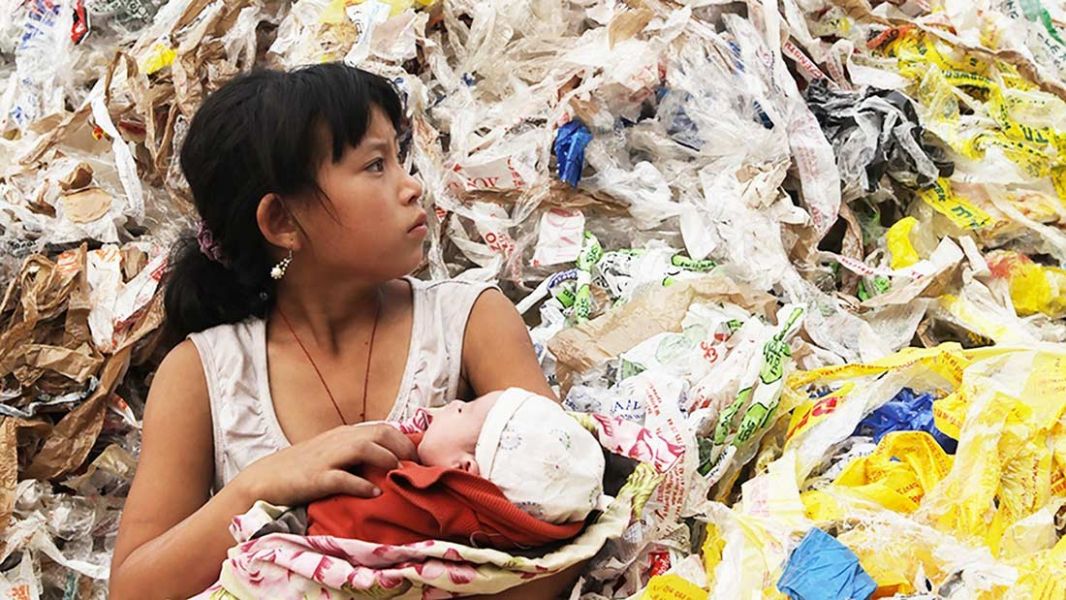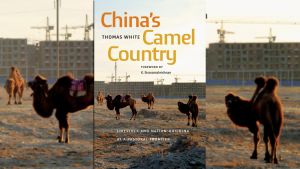
Plastic China: Beyond Waste Imports
In the last two years, the issue of waste exports to China has attracted considerable media and public attention. As a result, awareness of the social and environmental impact of the global trade in recyclables has increased substantially, both within and outside of China. Among contributing factors was Plastic China (suliao wangguo, 2016), a documentary directed by Wang Jiuliang. Since its release, the film has become indissociable from the issue of waste exports, and it gained even more prominence after July 2017, when the Chinese government announced a wide-ranging ban on ‘foreign waste’ (yang laji) (Liebman 2018). However, the film’s relevance extends far beyond the issue of waste management. In this essay, I argue that Plastic China should be considered as a rich social commentary and critique, and interpreted in the light of China’s tradition of independent documentary-making in the reform era.
China Wasting Away
Wang is a recognised authority on the topic of waste in China. He rose to prominence a few years ago thanks to his first film, Beijing Besieged by Waste (laji weicheng, 2012), which revealed the existence of a great number of unauthorised and unmonitored dumpsites around Beijing. The film also alerted people in China to the dangers of haphazard waste management, and drew attention to the sheer mass of waste generated by a city the size of Beijing.
Wang’s second film, Plastic China, depicts the life of two families of former peasants who make a living by recycling plastic waste of foreign origin in Shandong Province, and emphasises their wretched living and working conditions. It was featured in numerous festivals outside China, and has won several awards. In China, the film went viral in January 2017 before quickly disappearing from the Internet—thereby following a pattern that affects most of Wang’s work (Zhao 2017).
Wang’s first two films reveal the strong influence of what some refer to as China’s ‘new documentary movement’ (Berry and Rofel 2010). This is obvious in, among others, his choice of topic (China’s economic growth and opening to the world as experienced by the country’s underclass), his relationships with subjects (long-term involvement, much like that of an anthropologist), and his cinematographic style (observational realism involving on-the-spot and spontaneous shooting, a director who stands behind the camera, and the absence of voiceover). Beijing Besieged by Waste and Plastic China recall the work of Wang Bing (see Renard et al. 2014 and Persico 2010) and Zhao Liang (see Sorace 2017), among other leading Chinese independent filmmakers.
With Plastic China, Wang aimed to raise awareness of his homeland’s role in the global waste trade, and expose its negative repercussions on the Chinese population and environment. In 2014, Wang released an early, less narrative but more explanatory version of his documentary addressed at the media, in which he clearly frames the issue as environmental dumping. That same year, he expressed his intention to undertake a follow-up project on waste imports beyond plastics, which he tentatively titled Dumping Ground of the World (shijie de laji chang) (Liu 2014). It is therefore not surprising that Plastic China is generally invoked, both within and outside of China, in connection with the global capitalist system that, for many years at least, allowed relatively rich countries to pass the burden of pollution on to China.
The film has been particularly closely associated with the issue of waste imports since July 2017, when the Chinese central government hit headlines domestically and internationally by announcing a ban on imports of 24 categories of waste, including many types of plastics (Voice of America 2018). Several experts I engaged with in recent months put forward the idea that the film prompted officials in Beijing to take this kind of action, or at least influenced them significantly (see also Lü 2018). What is certain is that the film can serve as a justification for the outright ban on waste imports—irrespective of whether Wang ever regarded a ban as the proper solution to the problems he documented in his film. In this sense, Plastic China has arguably played a key role in the recent evolution of the trade in recyclable waste.
However, the film is all too often reduced to its function as a tool for denouncing environmental dumping. This is regrettable, for two main reasons. First, this narrow focus fails to do justice to the richness and complexity of Wang’s second, cinema version of Plastic China, which—unlike the first version targeting the press—constitutes a broad social commentary and critique. Second, this prevents us from understanding why the film was censored in China, when the denunciation of waste imports actually fits with the Chinese state’s increasingly restrictive policies on this issue since the 2010s. To compensate for this narrow focus, we need to look beyond the predominant reading.
Plastic China as Commentary and Critique
One first reason why Plastic China should be considered as a comprehensive reflection on the contemporary condition in China is that this is consistent with the director’s intention. In one interview about the film, Wang stated that: ‘China is a country that is facelifted, concealed, faked and unnatural. In other words, though it looks good exteriorly, it has a lot of interior problems’ (Kanthor 2017). In another one, he explained, in reference to the film’s title that:
The [word] ‘plastic’ here has two meanings: first it refers to the plastic waste, but at a deeper level it refers to the weakness beneath our surface prosperity; the way plastic surgery only improves appearance, not the reality. Years of rapid growth have made China appear prosperous, but pollution is having a huge impact on health … while China’s growth appears incredible, it is actually cheap and fragile. (Liu 2014)
In these excerpts, one finds a clear criticism, expressed in rather general terms, of China’s development model during the reform era, especially the pursuit of wealth at all costs.
Another factor that justifies adopting a broad interpretation of Plastic China is the wide range of social issues addressed by Wang. First of all his film tackles the problem of labour exploitation. The prosperity of China’s coastal regions relies on a massive inflow of migrant workers from the interior, who rarely have much bargaining power regarding their working conditions. In the film, Peng Wenyuan—who comes from Sichuan province, belongs to the Yi ethnic group, and is almost illiterate—complains repeatedly about his salary. He asks Wang Kun, his boss and the owner of the recycling workshop the Pengs work in, for a raise. But Kun—who is Han, from Shandong province, and can read and write—refuses, telling Wenyuan that he can always leave if he is not satisfied. In the cinema version of Plastic China, the concept of labour exploitation applies more clearly within China and even among former peasants than it does between China and the highly industrialised countries from which waste is imported. Thus, in a way, Wang departs from the perspective of environmental dumping. His focus on the daily life of two families in a shared domestic space, where exploitation unfolds in an intimate setting, allows him to give an otherwise commonplace phenomenon a particularly raw and emotional dimension.
In connection with this, the film represents a reflection on the legal status and living conditions of China’s ‘floating population’ (liudong renkou). In China, rural migrants are generally registered in their place of origin but spend most of their time living far away from their hometowns. During the reform era, this has prevented them from enjoying key rights and public services in their place of residence. Since 2014, China’s household registration system (hukou) is being eased with a view to, among other things, give migrants better access to healthcare and education. However, implementation of this reform only begun several years into the shooting of Plastic China (which lasted from 2011 to 2016), and remains patchy to this day. The Pengs’ precarious existence and the fact that they are basically left to fend for themselves is striking for both Chinese and foreign viewers. Among the film’s many harrowing scenes is that of Peng’s wife giving birth to her fourth child in the Wangs’ garden, with what looks like a total absence of medical assistance. The film does not tell its audience how this situation came about, but it is easy to associate it with rural migrants’ generally limited access to healthcare.
The documentary is also a meditation on issues of gender inequality. The picture of China’s gender regime that emerges from Plastic China is one of entrenched patriarchy, at least in the countryside, where boys are still valued more than girls (zhongnan qingnü). In the film, the main character, a bright girl named Peng Yijie, does not attend school, although she is already 11 years old. Viewers learn that this has to do with her status as a migrant, her family’s meagre earnings, and her father’s alcoholism. However, it is also strongly implied that Yijie’s gender played a role in her parents’ decision to neglect her education. At some point, Wang Kun pushes for Yijie to attend a local kindergarten, even offering to cover the costs, yet Yijie’s father, Peng Wenyuan, refuses, preferring that she continue to sort plastics, do household chores, and take care of her younger siblings. This contrasts with the situation of Wang Qiqi, Kun’s son, who is sent to the kindergarten so that he can pick up literacy skills early on in the hope that he will get access to a high-earning job later in life, ideally in an office in Beijing—it should be noted, however, that Qiqi is not only a boy, but also an only child.
A further issue highlighted in the film is that of conspicuous consumption. There is something profoundly disturbing in the Wangs’ purchase of a shiny new sedan car. The family obviously lives on very little, and Wang Kun, the breadwinner, has a possibly serious affliction that affects his capacity to work, and remains undiagnosed and untreated, partly because he fears that seeking medical attention could result in high expenses. Yet, towards the end of the film, the Wangs spend their entire savings—and even borrow money—to purchase a vehicle for which they seem to have little practical need. Acquiring this potent status symbol allows them to have the feeling—and give others the impression—that they have achieved wealth, and moved up the social ladder. The question remains, however, whether this was worth the enormous sacrifice in financial security, and viewers are left wondering what will happen to the family if Wang Kun is diagnosed with a serious illness.
The aspect of the film that most stuck with me personally was how Plastic China depicted the poor standard of waste management in rural China. Some scenes in the film take place in a dumpsite, where waste is burned in the open, or next to a river, where it accumulates. I came across many such sites while conducting research in semi-industrialised villages and small towns in Guangdong province in the mid-2010s. Some of them were located in rural recycling hubs, but many were not. For instance, Gurao, once China’s largest bra manufacturing hub, struggles with waste-related pollution of comparable gravity to that of neighbouring Guiyu, the country’s infamous e-waste recycling capital. Work done by environmentalists Chen Liwen and Mao Da from China Zero Waste Alliance (ling feiqi lianmeng) suggests that waste management is either lacking or highly inefficient in the Chinese countryside as a whole, and that much remains to be done in this field (Chitwood 2018).
The film also resonated with the study of China’s so-called ‘informal’ recycling world that I conducted in the mid-2010s (Schulz 2018). Through my interviews with self-made entrepreneurs who live in the countryside or have rural origins, I came to the conclusion that, as a rule, these people did not enjoy any support from state authorities for changing their methods or upgrading their facilities in order to cause less pollution, and better protect workers. There were virtually no incentives to comply with environmental and safety regulation, and local authorities made little effort to improve the sector—in large part because officials at the village or town level had a stake in rapid, unbridled economic growth. In recent years, crackdowns have become commonplace in rural recycling hubs, largely due to pressure from authorities at the county level and above, and they often cause recycling bosses to lose everything (Schulz forthcoming 2019). Such a context makes it very risky for the latter to adopt a long-term perspective and invest in new equipment or techniques. This also explains why Wang Kun’s plastic recycling workshop, like many others, relies on manual labour and a couple of unsophisticated and antiquated machines.
Plastic China and the Chinese Condition
All the issues mentioned above are central to Wang’s narrative in Plastic China. It is important to stress that, while these features of China’s contemporary condition can be observed in rural recycling hubs, they are not unique to these places. Indeed, they cut across borders and sectors of economic activity. An important implication is that improving the lives of the people who live in rural recycling hubs and engage in waste sorting and processing requires more than putting an end to waste imports—especially if imports are substituted with domestic waste, of which there is no shortage in China.
This brings us to the topic of censorship. If Plastic China’s message really boiled down to nothing more than a plea against waste imports and the pollution they cause, then the film would not be an obvious target for the Chinese censors. After all, this type of message is consistent with recent official discourse and practice, which lay great emphasis on environmental protection, leadership in global trade, and national sovereignty. If anything, there is considerable overlap between Wang’s film and the ‘foreign waste’ rhetoric that accompanies state authorities’ action in the field of transboundary movements of waste since the early 2010s, and predates the ban announced in July 2017. Moreover, Plastic China contains virtually no direct criticism of any government, state-owned enterprise, or other powerful entity—a key difference with Under the Dome (qiong ding zhi xia 2015), another documentary on China’s environmental predicament that also went viral and disappeared from the Internet in a matter of days.
Yet, something in Plastic China must have bothered Chinese censors, and prompted them to intervene. In the absence of any recognisably subversive content, I would argue that it was the image of China conveyed by Wang’s bleak and shocking depiction of the country’s recycling sector that struck a nerve. Since taking office as president, Xi Jinping has striven to distinguish his government from the previous one. He has vowed to break with the past, and usher in a ‘new normal’ (xin changtai)—later morphing into a ‘new era’ (xin shidai)—in which the country’s true wealth would reside in ‘clear waters and green mountains’ (lüshui qingshan), and its prosperity would rely on moderate and sustainable growth. It is against this backdrop that Plastic China came out in 2016. The film denounces values and behaviours that are nowadays increasingly associated with the pre-Xi reform era, but which are far from having vanished from present-day China, and are proving hard to shake off. It reveals the huge challenges faced by Xi’s project of ‘poverty eradication’ (xiaochu pinkun). The story of a girl’s sacrificed youth, in particular, works as an allegory that flies in the face of Xi’s watchwords and signature concepts of ‘rejuvenation’ (fuxing) of the Chinese nation and ‘Chinese Dream’ (zhongguo meng): Yijie’s life involves a toilsome present and an uncertain future marked by moments of hope inevitably punctuated by despair. Her dreams are daydreams, a way for her to escape the harsh reality she experiences on a daily basis. They take her elsewhere, to a place where she can picture a better life, and—most damning of all—it looks like this could be abroad.
In conclusion, Plastic China constitutes a broad reflexion on social problems and dilemmas in the post-socialist era. The film clearly belongs to China’s ‘new documentary movement’, which has created an important space for social commentary and critique since the early 1990s (Berry and Rofel 2010). There are clear signs that this space is shrinking nowadays, yet this does not stop many independent filmmakers from pursuing their mission (Berry 2017). Despite censorship, Wang Jiuliang has managed to reach a wide audience with Plastic China, and have considerable impact. Immediately afterwards, he embarked on a new project. Interestingly, it does not look further into waste imports, as Wang had originally planned, but instead addresses construction and real estate’s impact on the surface of the earth, in particular through mineral extraction and the desolate landscapes it produces in China (Wang 2016). Once again, though, Wang has a holistic way of tackling the issue, and his real concern is China’s changing relationship to the land under capitalism—a broad project if there ever was one.





